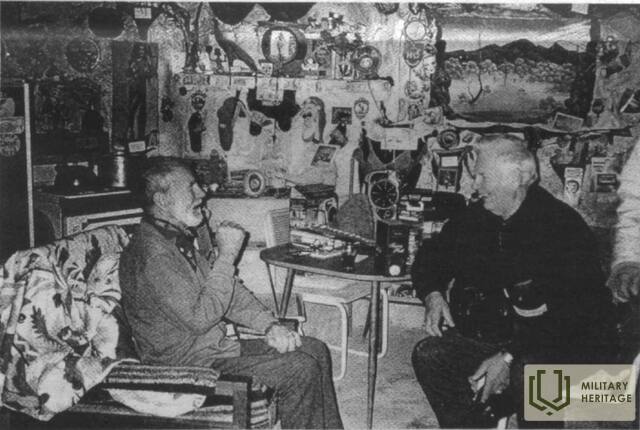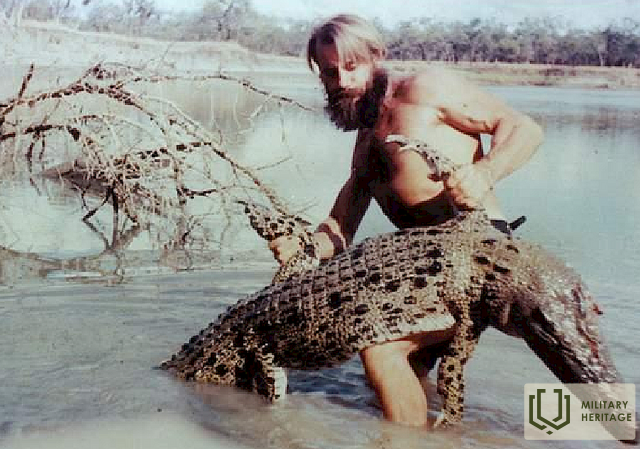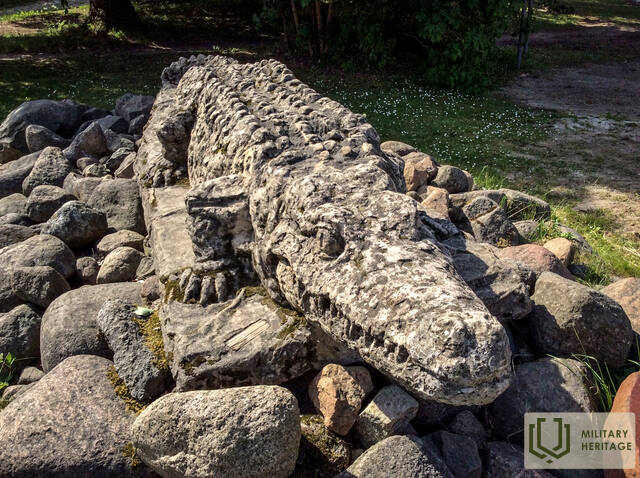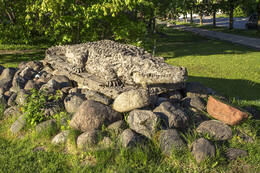Meeting with Arvīds Blūmentāls - Crocodile Harry in Cumberpedia
The newspaper "Australian Latvian" published an article about a meeting with Arvīds Blūmentāls at his home in Australia.
(A small episode from the journey to the roots of the Australian centre and west coast together with Aivars and Benita Browne.)
On our Darwin-Perth trip through Cumberland, we also decided to visit the famous author of "The Crocodile Hunter's Progress", Arvid Blumenthal, now a long-time resident of Cumberland, where he is known as Crocodile Harry. Although we had a rough guide to finding his home, in this opal mining town, where all the sandy roads between the excavated embankments of the opal fields look pretty much the same and there are no road or street names, we got a bit lost until we finally saw a sign at one turn in the road that said "Crocodile Harry". After about 5 km we come to a hillside. Entrance to a rocky slope. At the entrance there is a sign - Crocodile's Nest. The door is open. At the entrance to the crocodile park - leeja $2. Go inside the cave, say "Hello!" At first, Harry seems surprised, then happy to hear Latvian. As the rumours in town have already spread that he is a big fan of women, we are not surprised when he greets both Benita and me in a sweet, huggy way.
We talk very cosily and cheerfully, joking around, even picking up a Latvian song. We speak Latvian, to the amusement of a few other cave visitors. We look around Harry's abode - the caves, which are made up of different rooms. There are many different rooms dug into the rock, all of them so colourful that it is impossible to describe them, you would have to see them for yourself. All the walls, the ceilings, all the gorges are covered with various drawings, inscriptions, signatures of tourists, wishes. Then there are all kinds of souvenirs left by tourists, from hats to women's underwear. There is also a room where various flags, dresses, and a large Latvian flag are displayed, as if in a place of honour. There are various figurative formations in the rooms, including figures of naked women in various poses.
Well, if - already in the town, we were being wooed by "Harry loves women". Then Harry says "I'll show you something special". It's a separate room, dug into a separate rock - a cave, with the entrance on the other side, locked. This room is not shown to everyone. A room with faded walls, a ceiling, a crystal crown, a dark red tepee, plush furniture in gold, Harry says, "rococo style". There is no lack of television, no lack of video, there is a telephone, a security system, in short, nothing of modern life. This room, which is the complete opposite of the other rooms in his cave, is said to be for "Princess Sunflower", a special girl, whom, one could understand, he is still waiting for. We don't know who or what. He himself says that it is definitely not black. His electrical options are twofold - a 12 volt solar system for lighting, 240 volts from a diesel generator - for television, sound system, etc., also for digging opals, which he is still doing (still spry and strong at 77). Gas for cooking, fridge. Satellite dish for TV - can watch whatever he wants. Books in various languages, including Latvian, German, English, Russian, etc. When we ask him how he still knows Latvian so well after living away from the Latvian environment for so many years, he says that he reads and corresponds with Latvians. A really indescribable experience, an interesting person, also pleasant.
In the city, however, he says that he has both good and bad days. We will be lucky to be there on his good day. We have already spent a couple of hours there when it is time to say goodbye and move on. Benita leaves him a bowl of sauerkraut and hunter's sausages and a slice of rye bread as a farewell greeting, which he is very pleased about. At the exit, one last farewell greeting, one last hug. Until the last moment, as our cars disappear around the corner, he stands in the doorway, looking a little sad and waving his hand. I suppose he is sorry to be parted. Although tourists come to visit him often, it is not so common to meet Latvians.
Related timeline
Related topics
Related objects
Commemorative sign to Arvīds Blūmentāls "Crocodile"
The Crocodile Monument is located in Dundaga, at the intersection of Talsu and Ernesta Dinzberga Streets. The two-tonne monument to Arvīds and other Kurzeme strongmen was erected in Dundaga in 1995. The sculptor is Oļegs Skarainis. An exhibition dedicated to Arvīds Blūmentāls is also located nearby in Dundaga Castle.
The "Crocodile", which sits on a pile of stones, tells the story of a Dundadz man's long journey after the Second World War and his sudden worldwide fame, becoming one of the prototypes of the modern world's adventurers. When Crocodile Dundee hit cinema screens in 1986, it quickly became a worldwide success. As people became interested in the characters depicted in the film, it became clear that such colourful characters could not be fictional! It soon became clear that the prototype for the main character was Australian - and that it was the Australian hunter Rodney Ansel, or the Latvian boy Arvīds Blūmentāls.
Arvīds Blūmentāls was born in 1925 in the home of Būdenu, Dundaga parish. During the Second World War he joined the 25th Abava Police Battalion - building positions in the north of Liepāja and taking part in anti-partisan operations in Ukraine. After the battalion was incorporated into the Latvian Legion, he took part in its battles and was wounded several times. During the fighting in the war, he ended up in Germany, where he escaped to American-controlled territory. After training at the Altferfrad Agricultural School, he enlisted in the French Foreign Legion in 1947 and took part in the first Indochina War, after which he moved to Australia in 1951 and began hunting in the rainforests of northern Queensland. He himself said he hunted between 10 000 and 40 000 crocodiles in his lifetime. When the Australian government banned the hunt, he moved to an opal mine in the town of Cumberpedie, got married and set up housekeeping in a mine cave, which he named 'Crocodile's Lair'. Arvydas Blumenthal died on 13 October 2006. During his lifetime, he was the subject of several documentaries, his home, the Crocodile's Nest, was the setting for Mad Max Beyond Thunderdome, and he himself became a living legend.









